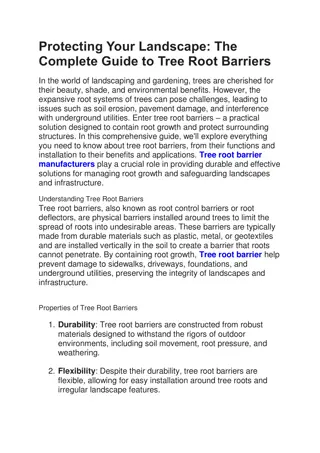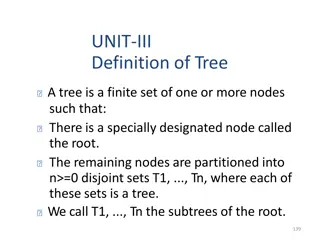
Understanding Binary Search Trees in Computer Science
Explore the concepts of binary search trees (BST) including their structure, operations, and efficiency in organizing data values for rapid access. Learn about the relationship between BST and binary trees, the conditions that make a tree a BST, and how they are utilized in computer science. Discover the importance of ordering values for BST implementation and the efficiency considerations when adding, removing, and finding data in different scenarios.
Uploaded on | 0 Views
Download Presentation

Please find below an Image/Link to download the presentation.
The content on the website is provided AS IS for your information and personal use only. It may not be sold, licensed, or shared on other websites without obtaining consent from the author. If you encounter any issues during the download, it is possible that the publisher has removed the file from their server.
You are allowed to download the files provided on this website for personal or commercial use, subject to the condition that they are used lawfully. All files are the property of their respective owners.
The content on the website is provided AS IS for your information and personal use only. It may not be sold, licensed, or shared on other websites without obtaining consent from the author.
E N D
Presentation Transcript
David Stotts Computer Science Department UNC Chapel Hill
Tree Data Structures binary tree binary search tree (BST)
lo lo Tree with arity 2 Every node has max of two children ok ok hi hi so so ya ya re re ad ad tu tu fa fa mi mi ti ti ok ok no no go go zz zz arity 2, a binary tree arity 2, a binary tree
L Linked structure inked structure BinCell { root: string left: BinCell right: BinCell }
A binary search tree (BST) is a with a in the nodes relates to each other A binary search tree (BST) is a binary tree with a special condition in the nodes relates to each other binary tree (BT) on how data values (BT) special condition on how data values BST is a subset of BT Every BST is also a BT Every BT is NOT necessarily a BST Some BT are not BST some are
A binary search tree (BST) gives us a way to organize a set of data values for rapid access A binary search tree (BST) gives us a way to organize a set of data values for rapid access At least, we want that At least, we want that We will see that adding and removing data, a and finding data, w will be efficient but might be We will see that adding and removing data, nd finding data, ill be efficient on average but might be bad if we hit on average bad if we hit worst case worst case
Binary tree Binary tree with extra conditions val > all vals in val < all vals in let s assume no duplicates for now and are both BST ?? with extra conditions ?? ?? val val ?? ?? ?? We can use a BST when the values can be ordered Ex: int, real, string, char Won t work for organizing images, files, functions, etc. unless you can define some lessThan, Eq functions for the data
6 6 6 6 2 2 8 8 2 2 8 8 1 1 4 4 7 7 5 5 1 1 4 4 3 3 5 5 3 3 7 7 Binary, and is BST Binary, and is BST Binary, but not BST Binary, but not BST
1 1 7 elements in each 7 elements in each 2 2 6 6 3 3 2 2 9 9 5 5 is BST is BST 1 1 5 5 7 7 6 6 is BST is BST height is height is 6 6 7 7 3 3 height is 3 height is 3 9 9
Log base 2 of 1,000,000 is about 20 guesses Random (linear) guessing takes avg 500,000 guesses Log base 2 of 1,000,000 is about 20 Random (linear) guessing takes 500,000 guesses I m thinking of a number between 1 and 1,000,000 You guess at it I ll say higher, lower, or bingo I m thinking of a number between 1 and 1,000,000 Is there a max # of guesses to get my number? Is there a max # of guesses to get my number? Yes use binary search Guess 500,000 If I say lower you know 500,001 and up are not it You can cut the space in half, only guess below 500,000 avg of of Next guess is 250,000 repeat How Max is ???2 1,000,000 in general, O( ???2 ? ) for N numbers How many time can we cut 1,000,000 in half until we hit many time can we cut 1,000,000 in half until we hit 1 ? 1 ? or just O( log N ) O( log N )
8 8 12 12 4 4 10 10 14 14 2 2 6 6 11 11 9 9 7 7 5 5 1 1 3 3 13 13 15 15 Complete binary tree eight h is 3 Complete binary tree h height h is 3 #nodes = ( #nodes = (??+?) )- -1 1
OO Signature OO Signature new: BST insert: Elt Boolean remove: Elt Boolean findMin: Elt findMax: Elt contains: Elt Boolean (searching) get: Elt BST (return a cell) val: Elt (get root value) Int+ (non-negative integers) empty: Boolean height: Int+ size:
c contains(3) ontains(3) 6 6 Start at root is root val Start at root is root val 3 ? 3 ? v val al: 6 : 6 no, so is root no, so is root val Yes, so go left val > 3 ? > 3 ? Yes, so go left 2 2 8 8 Is left root val No, so is val No, so go right Is left root No, so is No, so go right val = 3 ? val > 3 ? = 3 ? > 3 ? v val al: 2 : 2 1 1 4 4 Is right root No, so is Is right root val No, so is val yes, so go left val = 3 ? val > 3 ? = 3 ? > 3 ? v val al: 4 : 4 3 3 yes, so go left Is right root yes, Is right root val yes, so we got it val = 3 ? so we got it = 3 ? v val al: 3 : 3
In node object contains ( elt ) if ( this.val == elt ) { } else if ( this.val > elt ) { } else { } 6 6 // found it return true; 2 2 8 8 1 1 4 4 // item has to be in left subtree return this.LChild.contains(elt); 3 3 // this.val < elt, so elt has to be in right subtree return this.Rchild.contains(elt); But this is not complete No false returns
In node object contains ( elt ) if ( this.val == elt ) { } else if ( this.val > elt ) { } else { } 6 6 // found it return true; 2 2 8 8 1 1 4 4 // item has to be in left subtree if (this.LChild ==null) return false; else return this.LChild.contains(elt); 3 3 // this.val < elt, so elt has to be in right subtree if (this.Rchild==null) return false; else return this.Rchild.contains(elt);
i insert(5) nsert(5) 6 6 6 6 2 2 8 8 8 8 2 2 1 1 4 4 7 7 7 7 1 1 4 4 3 3 5 5 3 3 Write code like contains Write code like contains at 4 we see no R link so 5 is not there and we have the right spot to put it in at 4 we see no R link so 5 is not there and we have the right spot to put it in
In node object insert ( elt ) if ( this.val == elt ) { } else if ( this.val > elt ) { } else { } 6 6 // found it return false; 2 2 8 8 // item has to be in left subtree if ( this.LChild return true; } }; ; else return this.LChild.insert(elt); // recursion if (this.LChild this.LChild = new Node( return true; this.LChild ==null) { ==null) { = new Node(elt 1 1 4 4 7 7 elt); ); 5 5 3 3 // this.val < elt, so elt has to be in right subtree if ( this.RChild return true } } else return this.Rchild.insert(elt); // delegation one node to another if (this.Rchild this.RChild = new Node( return true; ; this.Rchild==null) { ==null) { = new Node(elt elt); );
8 8 12 12 4 4 10 10 14 14 2 2 6 6 11 11 9 9 7 7 5 5 1 1 3 3 13 13 15 15 Follow left links until hit null Follow left links until hit null findMax: : follow right links findMax follow right links
contains the node of interest If leaf If has 1 child If leaf, just unlink it If has 1 child, just make parent point to child 6 6 6 6 2 2 2 2 8 8 8 8 4 4 4 4 1 1 1 1 3 3 r remove(4) emove(4) 3 3
If has 2 children, findMin in R subtree Replace node val being deleted with this min val If has 2 children, then then 6 6 6 6 3 3 8 8 2 2 8 8 5 5 5 5 1 1 1 1 3 3 3 3 remove(2) remove(2) copy value copy value 4 4 4 4
(2 children) Recursive delete the min node It will not have a L subtree so now it s a one or no child case here, it s 1 child 6 6 (2 children) then then 6 6 3 3 8 8 3 3 8 8 6 6 1 1 5 5 5 5 3 3 1 1 8 8 3 3 3 3 1 1 5 5 Remove min in R Remove min in R 4 4 4 4 4 4
If has 2 children, then Can also do this shows) If has 2 children, then Can also do this with findMax in L subtree (as the animation page 6 6 6 6 6 6 1 1 8 8 2 2 8 8 1 1 8 8 5 5 1 1 5 5 1 1 copy value copy value Remove max in L Remove max in L 5 5 3 3 3 3 4 4 3 3 4 4 remove(2) remove(2) 4 4
BST get more linear as we do more deletes BST very useful for largely static data sets like lexicons (OED) Sometimes do a fake remove (lazy delete) where we mark the node as inactive but leave it linked into the tree structure . Not too bad if we don t do many removes See animations for BST See animations for BST
1 1 Depth depends on order of inserts Insert(1) Insert(2) Insert(3) Insert(5) Insert(6) Insert(7) Insert(9) 9 9 Depth depends on order of inserts 2 2 3 3 5 5 6 6 7 7 height is 6 height is 6 unlucky arrival order unlucky arrival order
Depth depends on order of inserts Insert(6) Insert(2) Insert(9) Insert(5) Insert(1) Insert(7) Insert(3) Depth depends on order of inserts 6 6 2 2 9 9 1 1 5 5 7 7 3 3 height is 3 height is 3 t tree is more balanced ree is more balanced
8 8 12 12 4 4 10 10 14 14 2 2 6 6 11 11 9 9 7 7 5 5 1 1 3 3 13 13 15 15 Complete binary tree eight h is 3 Complete binary tree h height h is 3 #nodes = ( #nodes = (??+?) )- -1 1
Linked: Linked: Time complexity of operations insert worst: O(n), avg: O(log n) remove worst: O(n), avg: O(log n) findMin worst: O(n), avg: O(log n) findMax worst: O(n), avg: O(log n) contains worst: O(n), avg: O(log n) get worst: O(n), avg: O(log n) empty O(1) size O(1) (keep counter) val O(1) (root access)
Worst case is the pathological data set insert order that leads to linear structure Pathological data sets are nearly in order already Average behavior happens when data arrival order is randomly (uniformly) distributed throughout data value range
How? Big-Oh complexity?
First build a BST that contains all elements you wish to sort in- -order (L then R) will produce sorted order, smallest to largest 10 10 12 12 5 5 Then an in order traversal 2 2 7 7 17 17 11 11 1 1 14 14 9 9 6 6 In In- -order (LR): 1,2,5,6,7,9,10,11,12,14,17 order (LR): Note: sorted order high to low Note: In-order but R then L will give
Building a BST of N elements: N inserts Each insert is O(N) * O(log N) In-order traversal visit each N nodes O(N) Build tree and then traverse: O( N log N ) + O( N ) N inserts Each insert is avg O(N) * O(log N) avg O(log N) avg O(log N) O(height of the BST) avg O( N log N ) O(height of the BST) O( N log N ) O(N) O( N log N ) + O( N ) O( N + N log N ) O( N * ( 1+ log N ) ) O( N + N log N ) O( N * ( 1+ log N ) ) avg avg O ( N log N ) O ( N log N )
Sort with a SLIST (self-sorting list) N inserts, each insert is O(N): O(N)* O(N) Traverse list: O(N) Make SLIST and traverse: N inserts, each insert is O(N): O(N)* O(N) Traverse list: O(N) Make SLIST and traverse: O(N) + O( O( ??) ) ) O(N) + O( O( ??) ) O( O( ??) Build a BST and traverse: O( N log N ) + O( N ) O( N log N ) + O( N ) O( N + N log N ) O( N * ( 1+ log N ) ) O( N + N log N ) O( N * ( 1+ log N ) ) avg avg O ( N log N O ( N log N ) ) So we are improving sort of So we are improving sort of
Worst case? N inserts worst case for each insert is O(N) Traversal is O(N) Worst case for sort is O(N) + O(N^2) No improvement in worst case Worst case? N inserts worst case for each insert is O(N) Traversal is O(N) Worst case for sort is O(N) + O(N^2) is O(N^2) is O(N^2) No improvement in worst case
Compare O( ?2 ) vs. O( N log N ) Consider a sequence of 1,000,000 items O( ?2) is 1,000,000 * 1,000,000 O(N log N) is 1,000,000 * log(1,000,000) is 1,000,000 * 20 20 secs 20 secs So if a computer does 1 million ops per second So if a computer does 1 million ops per second 1 million secs 1 million secs 1 million secs is 277 1 million secs is 277 hrs i is s 11.5 hrs days 11.5 days
These two BSTs contain the same elements 8 8 These two BSTs contain the same elements 9 9 12 12 10 10 3 3 4 4 9 9 1 1 4 4 12 12 10 10 8 8 1 1 3 3 In In- -Order traversal gives same order (sorted) for each Order traversal gives same order (sorted) for each 1, 3, 4, 8, 9, 10, 12 1, 3, 4, 8, 9, 10, 12
Any two BSTs with the same elements have the same sequence generated by In-Order traversal Post means different sequence Pre means different sequence Any two BSTs with the same elements in them will Post- -Order: Order: root is always last, so different root Pre- -Order Order: : root is always first, so different root
8 8 12 12 4 4 10 10 14 14 2 2 6 6 11 11 9 9 7 7 5 5 3 3






















